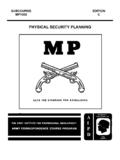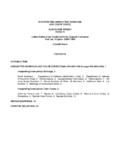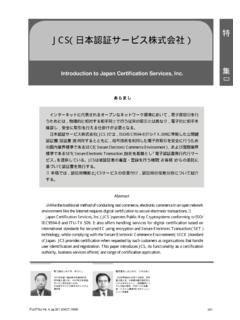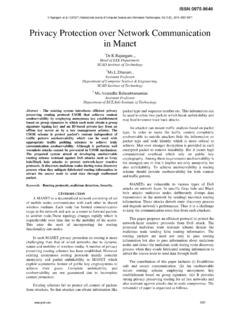Transcription of COMMUNICATIONS SECURITY (SC 25C-RC)
1 SUBCOURSE EDITION. SS0137 A. US ARMY SIGNAL CENTER AND FORT GORDON. COMMUNICATIONS SECURITY . (SC 25C-RC). EDITION DATE: SEPTEMBER 1994. COMMUNICATIONS SECURITY . Subcourse SS 0137. Edition A. United States Army Signal Center and Fort Gordon Fort Gordon, Georgia 30905-5000. 7 Credit Hours Edition Date: September 1994. SUBCOURSE OVERVIEW. This subcourse is designed to teach about COMMUNICATIONS SECURITY (COMSEC), including COMSEC custodian duties, identifying COMSEC material, cryptofacility approval, physical SECURITY of COMSEC material and keys, COMSEC accountability, COMSEC emergency plans, and COMSEC-related inspections and audits.
2 The prerequisite for this subcourse is that you are a graduate of the Signal Officer Basic Course or its equivalent. This subcourse reflects the doctrine which was current at the time it was prepared. In your own work situation, always refer to the latest official publications. Unless this publication states otherwise, masculine nouns and pronouns do not refer exclusively to men. TERMINAL LEARNING OBJECTIVE. ACTION: Describe the duties involved in managing a COMSEC account. CONDITION: Given this subcourse. STANDARD: To demonstrate competence on this task, you must achieve a minimum of 70 percent on the subcourse examination.
3 I SS0137. TABLE OF CONTENTS. Section Page Subcourse i Administrative Grading and Certification iv Lesson 1: Purpose of COMMUNICATIONS SECURITY ..1-1. Practice Exercise .. 1-8. Answer Key and Feedback ..1-10. Lesson 2: Establishing a Practice Exercise .. 2-6. Answer Key and Feedback ..2-8. Lesson 3: Identifying COMMUNICATIONS SECURITY Practice 3-6. Answer Key and Feedback ..3-8. Lesson 4: Accountability Within the COMSEC Material Control 4-1. Practice Exercise .. 4-6. Answer Key and Lesson 5: Physical SECURITY for COMMUNICATIONS 5-1.
4 Practice 5-6. Answer Key and SS0137 ii Section Page Lesson 6: COMMUNICATIONS SECURITY Emergency Plans .. 6-1. Practice Exercise .. 6-8. Answer Key and Lesson 7: COMMUNICATIONS SECURITY Inspections and 7-1. Practice Exercise .. 7-8. Answer Key and Feedback ..7-10. Appendix: Acronyms and Abbreviations ..A-1. Student Inquiry Sheets iii SS0137. PURPOSE OF. COMMUNICATIONS SECURITY . FOR OFFICIAL USE ONLY. LESSON 1. PURPOSE OF COMMUNICATIONS SECURITY . CRITICAL TASKS: OVERVIEW. LESSON DESCRIPTION: In this lesson, you will learn about COMSEC, to include its purpose and the threat it counters.
5 TERMINAL LEARNING OBJECTIVE: ACTION: Describe the purpose of COMSEC, its vulnerabilities, and countermeasures. CONDITION: Given this lesson. STANDARD: To demonstrate competence, you must achieve a minimum of 70 percent on the subcourse examination. REFERENCES: The material in this lesson was derived from the following publications: AR 380-5, AR 380- 19, FM 24-1, FM 100-5, and TB 380-41 series. INTRODUCTION. A battle's outcome often depends on the SECURITY , quality, and timeliness of COMMUNICATIONS . Only the enemy is totally aware of the quality of our COMSEC.
6 Every soldier must be trained to understand the importance of maintaining secure COMMUNICATIONS . Soldiers' lives depend on effective COMSEC. The weaker our COMSEC. efforts, the easier it is for an enemy to exploit our COMMUNICATIONS . 1-1 SS0137. 1. General. All electrical devices produce some form of emissions. Certain devices can capture those emissions, sort them, determine their general origin, and determine their meanings. These emissions have two forms. Some involve COMMUNICATIONS (radio) and others do not (radar and so forth).
7 The gathering and interpreting of these missions are called COMMUNICATIONS intelligence and electronic intelligence. However, complex systems and techniques to intercept and interpret these emissions are not needed if basic COMSEC. practices are ignored. 2. COMMUNICATIONS SECURITY . COMSEC is the protection resulting from measures designed to deny unauthorized persons information of value gained from having access to and studying our COMMUNICATIONS . It involves ensuring the authenticity of such COMMUNICATIONS . Figure 1-1 shows the COMSEC elements.
8 Figure 1-1. COMSEC elements. a. Emission SECURITY helps deny information from unauthorized persons. An enemy will likely intercept what is sent. One method is to observe total silence. This involves turning off all radiating systems. Another is selective silence where only certain systems operate during specific periods. An enemy unit that does not know about a friendly unit cannot get targeting or other data. Denial is easier when operators: (1) Mask antenna locations. (2) Use directional antennas. (3) Keep transmissions as short as possible.
9 (4) Use the minimum power needed to pass information. b. Transmission SECURITY (TRANSEC) protects transmissions from being intercepted and exploited, except by cryptoanalysis. (1) The key to TRANSEC is organized, succinct, and well thought out messages to keep transmission time to a minimum. Give only what is needed to those who need it SS0137 1-2. Try to keep transmissions to 15 seconds or less. Longer periods increase the odds an enemy will intercept and exploit a message. (2) Poor TRANSEC may make the sending unit an information source for an enemy.
10 The enemy may not target that unit for destruction until it outlives its usefulness. (3) Operators must avoid unauthorized discussions and chatter. Trained enemy signal analysts can exploit them. Topics for operators to avoid include: (a) Locations and equipment. (b) communication problems. (c) Morale and operations. c. Cryptosecurity uses approved systems to keep COMMUNICATIONS secure. Cryptosecurity involves: (1) Providing technically sound cryptosystems. (2) Ensuring their proper use. d. Physical SECURITY involves protecting equipment, material, and documents from access or observation by unauthorized persons.





